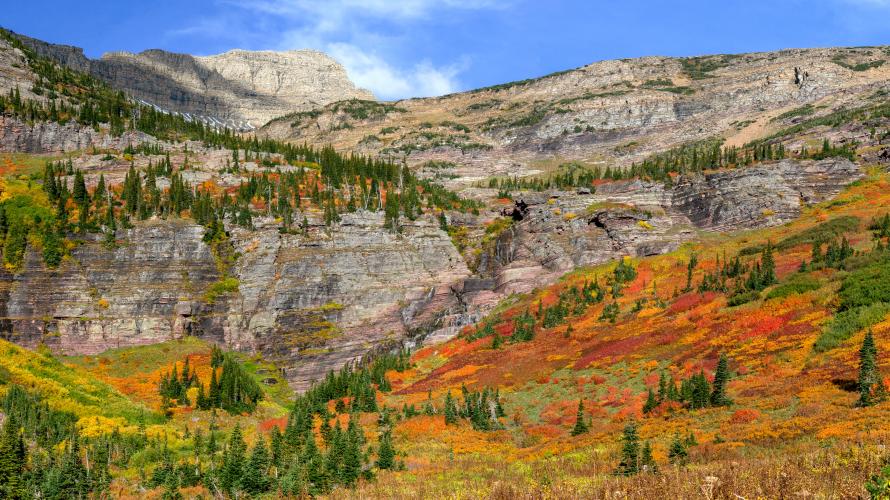
Hunting Color
~Doug Stevens
For 30-some years, I was an avid bowhunter. The whole year revolved around September. All the summer’s hiking, backpacking and fishing were geared towards getting in shape for the hunting season and scouting new or familiar hunting areas. I found bowhunting a way of extending the summer wilderness experiences through September, but with a different, more intense focus now – elk.
The routine my partner and I followed is probably not uncommon among bowhunters. We would backpack into an area that we previously scouted and set up a base camp. In the morning we would get up early (in the dark) and hike to where we were going to hunt. We would hunt from daybreak until mid morning (10 or 11-ish), then head back to camp for a rest/nap/eat. Around mid-afternoon, we would head out again to be hunting in late afternoon until around sunset. These are the times we found the elk to be the most active. We would typically cover a lot of territory during a given day of hunting. It was tiring, but fun – even if we came up empty. If and when we did get lucky, there was a lot of work after the kill, too – dressing out the animal, packing it out and processing it at home ourselves.
However, a few years ago I hung up my bow for the last time. Near the end, I was just not getting the same “kick” out of it as I did when I started. I guess it was because more and more people are taking up the sport and it was becoming less of a wilderness experience for me. Our hunting areas began to feel “crowded”. Additionally, my long time hunting partner moved away and hunting alone was just not the same.
Now, when September rolls around, I reach for my camera and pack it into the backcountry, instead of my bow. I get to take a lot more “shots” with my camera than I ever did with my bow and it doesn’t require a partner. More territory is open to explore with a camera, such as national parks, which are, of course, off limits to hunting. Also, if there are other people on the trail, it doesn’t scare off the photographic “game”, i.e., our spectacular Montana landscapes.
One of the reasons I had enjoyed bowhunting so much was to be out in September. It really is the most fantastic month of the year. The weather, for my liking, is the best! Cool nights and sunny warm days (with the possibility of the odd snow storm). As the month wears on, the progression of fall colors are simply stunning. Its not just about the golden aspens and cottonwoods. Further up, above most aspens, where we would typically hunt, the changing colors of the high elevation brush paints their own palette. From the bright yellows of the ceanothus and columbines through the burnt orange of the changing mountain ashes with their bright red berries, to the brick red of huckleberry, fireweed and grouse whortleberry bushes. It all adds up to a veritable profusion of colors. Now mix in a dusting of snow on the higher peaks to really enhance their grandeur - and the stage is set – and all this to the soundtrack of elk in rut with the bulls bugling at each other - wow! It’s a month I wish I could just freeze in time. It comes and goes for too quickly.
Recently, I was in Glacier National Park to try to capture some of those fall colors. I had targeted a couple of specific areas and knew what times to be there. As I was hiking in early one morning (serenaded by several bugling bulls), it struck me how similar my approach to fall photography is to the bowhunting I used to do. In effect, bowhunting prepared me for fall photography. Let me explain.
Photographers often talk about “golden hour”. That is the time just after sunrise, and again, a little before sunset, when the sun is low, has a more yellow hue and casts longer shadows. It saturates the colors, accentuates the textures and makes photos much more pleasing (of course, it does actually last longer than an hour). Most photographers, especially landscape photographers, always aim for this time, as well as try to catch the colors of a sunrise or a sunset. Timing is everything.
Since I like to photograph areas that are often in the backcountry and require a hike to get to, it is necessary to do some planning ahead of time. That means first scouting them out (would it make a better early morning or late afternoon photo?), getting up in the dark to hike in so as to be there at or near sunrise, staying until the sun is too high for the better light (say around 10 or 11-ish), then heading back to camp or the truck for a rest/nap/eat. By mid-afternoon, I am heading out again to be at the next location by late afternoon and maybe staying on to catch a great mountain sunset, then hiking out. I tend to cover a lot of territory to get the photos I want. When I get home, there is always a lot of work to do processing the photos. Hmmm, sounds familiar, doesn’t it? Just like my bowhunting routine!
So now, when September rolls around, I grab my camera, not my bow, because I’m not hunting elk, I’m hunting color!
Happy Trails!
